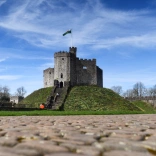Around AD75, Roman settlers built the mighty fortress of Isca Augusta in what is now Caerleon in South Wales. One of only three permanent fortresses in Roman Britain, it housed a 5000-strong force of the Second Augustan Legion, and defended the furthest outpost of their empire for two centuries. Step back 2,000 years at the National Roman Legion Museum, which brings this fascinating period of our history to life. Here are a few can’t-miss highlights.
History unearthed
Of all the treasures discovered in and around Caerleon since the 1600s and displayed at the National Roman Legion Museum, the stone coffin is one of the most impressive. Made from a single block of Bath stone, the coffin contains the 1,800-year-old remains of a man of moderate build who died around 40 years of age. Not a bad innings for the time. There’s also a Roman-style painting showing what the coffin’s occupant might have looked like.


Ancient letters
In pride of place at the museum is a tablet, found in a well on the site. It’s not complete, but you can still make out the Roman words on it, written in ink. Dating back to the 1st century, it’s the oldest surviving writing in Wales, beating the oldest remaining Welsh writing by about six centuries. Also on display are several memorial stones including a beautifully carved stone for resident Tadia Vallaunius and her son, soldier Tadius Exuperatus, who died on an expedition to Germany.

In the money
Heaps of treasure are on display at the museum. You can admire one of the finest hoards of silver coins from second century Roman Britain, 599 in all, found by a local metal detector enthusiast in 2006. There’s also the largest collection of engraved gemstones in Britain. As small as a fingernail but etched with exquisite designs of gods and animals, this glittering stash of gems was discovered in the bathhouse drain.


Glimpses of past lives
The museum houses a large collection of everyday items that shed light on everyday life in Roman times. Among the curiosities at the museum are stamps used to mark bread and a third century iron frying pan with a folding handle, designed to fit inside a soldier’s pack. The decayed children’s milk teeth, found, like the gemstones, in the bathhouse drain are perhaps a reminder of how little has changed since Roman times. It seems that kids loved sweet treats then just as much as they do now.


Flower (and bunk) beds
The Roman-inspired garden at the museum is the perfect place to take a break from exploration. Planted with herbs and flowers used by Caerleon’s Roman residents in food and medicine, it’s a treat for all the senses. There’s also a recreation of a barrack room, where legionaries would have lived and slept. There aren’t too many home comforts, so you probably wouldn’t fancy spending the night, but there is replica armour to try on if you feel like getting a taste of life in the Roman army.


Showtime
Caerleon’s amphitheatre is the most complete example in Britain. For the residents of Isca the perfect night out was a thrilling show of hand-to-hand combat, blood and gore. We prefer the rugby ourselves, but there’s no accounting for taste.


Making a splash
Apart from bloodthirsty entertainment in the amphitheatre, the Romans liked nothing better than a good bath. A section of Isca Augusta’s original bath house remains and can be viewed at the Caerleon Fortress Baths. Beautifully brought to life with sound and light effects, you’ll find out about the caldarium, tepidarium, frigidarium and natation. They might sound like spells from the Harry Potter books, but they’re actually pools with different temperatures. The Romans clearly knew what they were talking about when it came to R&R. Posh spas still use the same principles today.


In the army now
Caerleon has the only legionary barracks on show in Europe. In a grassy field west of the Museum, the remains of four long, narrow blocks of 12 pairs of rooms can be seen, each fronted by a veranda. There’s also a larger suite at the end where the Centurion would have lived, presumably in a bit more comfort than the rank and file soldiers.


Get involved
The National Roman Legion Museum has an active events programme throughout the year. It you’d like to see soldiers in Roman armour, experience Roman cooking, find out about Roman medicine or celebrate Saturnalia, the lively Roman midwinter festival, this is the place. Subject to availability, please check before you visit.
Search for more Roman historical sites and attractions across Wales.







